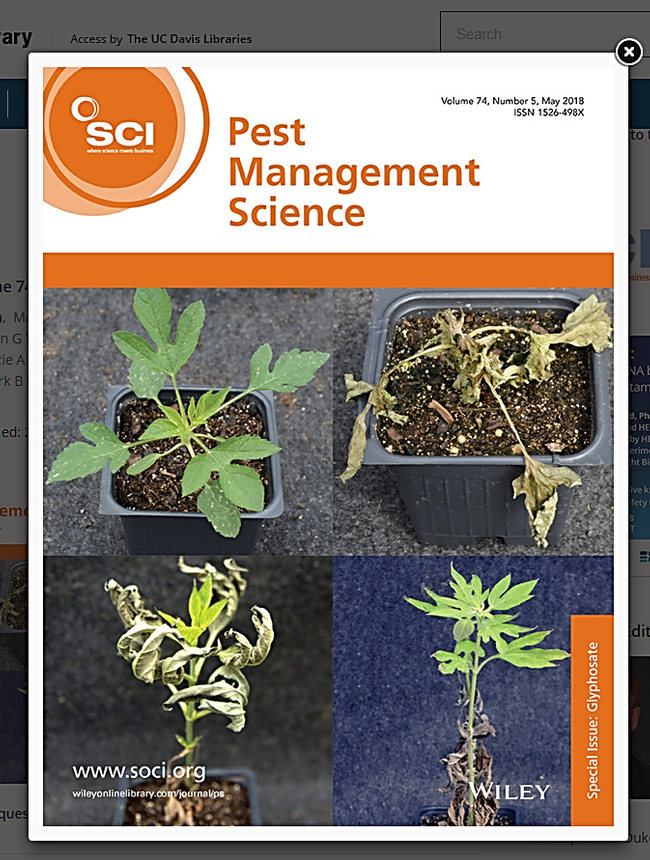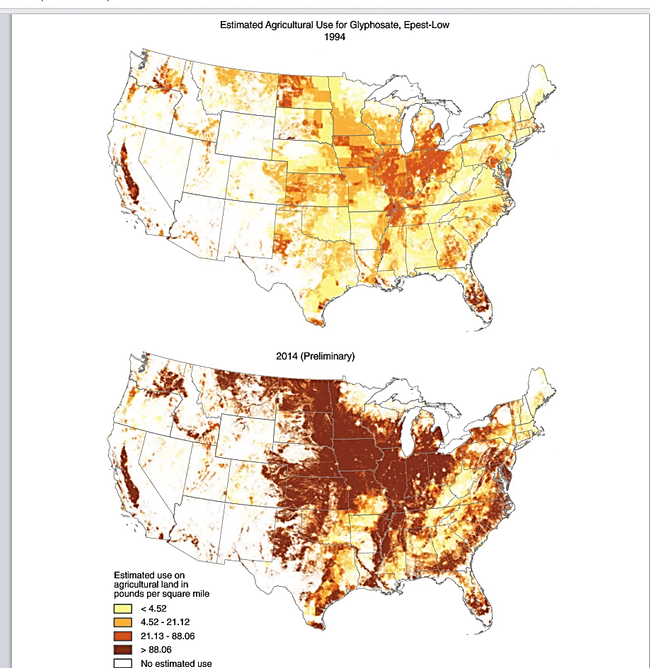Glyphosate was commercialized in 1974. Since then, it has become one of the most widely used and studied herbicides. According to Duke (2018b), almost 20,000 scientific publications and patents have included glyphosate as a focus; only 2,4-D surpasses it with respect to citations. The articles in the 5th issue of the 74th volume of Pest Management Science are no different; they all focus on this important (and controversial) molecule.This special issue arose from a day long symposium organized by Stephen O. Duke (University of Mississippi) and Keith Solomon (University of Guelph) that was held at the 252nd annual meeting of the American Chemical Society (Duke 2018a).
Figure 1. The cover of the 5th issue of the 74th volume of Pest Management Science, which is dedicated, entirely, to articles about glyphosate. The cover photos are based on the research article: Glyphosate resistance in Ambrosia trifida: Part 1. Novel rapid cell death response to glyphosate.
Stephen Duke (2018) updates a previous publication describing glyphosate's history and use (Duke and Powles 2008) in the first article. Of interest to the California weed science community is how consistent glyphosate use appears to be in the Central Valley between 1994 and 2014 as compared to the rest of the United States (Figure 2). Glyphosate has been a relative staple for weed control in our tree and vine systems over this time whereas the development and release of glyphosate-resistant crops (GRCs) has expanded the molecule's utility in row crop agriculture.
Figure 2. An image showing changes in glyphosate use in the US between 1994 and 2014 from the review article: The history and current status of glyphosate.
Jerry Green (2018) describes the history and discusses the future of GRCs, which currently account for more than 50% of the glyphosate applied in the world. While recognizing the influence of GRCs on weed control, both Green (2018) and Heap and Duke (2018) acknowledge that the widespread use of this active ingredient over space and time has lead to the development of glyphosate-resistant weeds. Worldwide, there are 41 weed species (24 dicots, 17 monocots) with resistance to glyphosate. In the United States, 17 weed species have documented resistance to glyphosate; in California, glyphosate resistance has been confirmed in: Amaranthus palmeri, Conyza bonariensis, Conyza canadensis, Echinochloa colona, Lolium perenne, Lolium rigidum, and Poa annua. Heap and Duke (2018) note that the development of glyphosate resistance in species with resistances to other herbicides may precipitate a management crisis for growers that rely heavily on chemical tools for weed control. Considering the rise in the numbers of species with multiple resistances and the lack of a.i. introductions, the authors advocate for the adoption of integrated management efforts (e.g. physical and cultural practices), the judicious use of effective herbicides, an evaluation of herbicide a.i.s for their suitability in additional crops, and a continued focus on advancing computing and engineering to facilitate precision weed removal.
The remainder of the articles in the issue are split between reviews and research papers. The reviews focus on: the impacts of glyphosate resistant sugar beets (Morishita 2018); the effects of glyphosate on plant disease development (Hammerschmidt 2018); and the hermetic effects of glyphosate on plants (Brito et al. 2018). The original research articles describe: a novel mechanism of resistance to glyphosate in Ambrosia trifida (Van Horn et al. 2018; Moretti et al. 2018); the effects of temperature on glyphosate absorption in Kochia scoparia (Ou et al. 2018); the spread of the glyphosate resistance trait in Palmer amaranth (Molin et al. 2018), among many others.
Considering the importance of glyphosate to crop production in California, the United States, and the world, this issue of Pest Management Science is likely to be an importance reference. It can be accessed at the journal's webpage: https://onlinelibrary.wiley.com/toc/15264998/74/5
Citations:
Brito, et al. 2018. Hormetic effects of glyphosate on plants. Pest Manage Sci 74:1064-1070.
Duke, SO and SB Powles. 2008. Glyphosate: A once-in-a-century herbicide. Pest Manage Sci 64:319-325.
Duke, SO. 2018a. Glyphosate: The world's most successful herbicide under intense scrutiny. Pest Manage Sci 74:10-26-1026.
Duke, SO. 2018b. The history and current status of glyphosate. Pest Manage Sci 74:1027-1034.
Green, JM. 2018. The rise and future of glyphosate and glyphosate-resistant crops. Pest Manage Sci 74:1035-1039.
Hammerschmidt, R. 2018. How glyphosate affects plant disease development: it is more than enhanced susceptibility. Pest Manage Sci 74:1054-1063.
Heap, I and SO Duke. 2018. Overview of glyphosate-resistant weeds worldwide. Pest Manage Sci 74:1040-1049.
Molin, WT et al. 2018. Survey of the genomic landscape surrounding the 5-enolpyruvylshikimate-3-phosphate synthase (EPSPS) gene in glyphosate-resistant Amaranthus palmeri from geographically distinct populations in the USA. Pest Manage Sci 74:1109-1117.
Moretti, ML et al. 2018. Glyphosate resistance in Ambrosia trifida: Part 2. Rapid response physiology and non-target-site resistance. Pest Manage Sci 74:1079-1088.
Morishita, DW. 2018. Impact of glyphosate-resistant sugar beet. Pest Manage Sci 74:1050-1053.
Ou, J et al. 2018. Reduced absorption of glyphosate and decreased translocation of dicamba contribute to poor control of kochia (Kochia scoparia) at high temperature. Pest Manage Sci 74:1134-1142.
Van Horn, CR et al. 2018. Glyphosate resistance in Ambrosia trifida: Part 1. Novel rapid cell death response to glyphosate. Pest Manage Sci 74:1050-1053.

